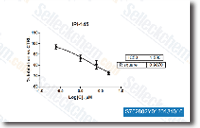Despite preclin ical studies, a few PI3K inhibitors for NHL remedy are at present undergoing different phases of clinical trials. Here we’ll give attention to the clinical build ment of PI3K inhibitors for NHL. PI3K inhibitors in follicular lymphoma Follicular lymphoma is among the most typical types of indolent NHL. In spite of its indolent phase, about 25% 60% of them sooner or later transform into diffuse significant cell lymphoma, a variety of aggressive lymph oma. Mixture treatment integrated rituximab are unable to sig nificantly decline the relapse price of FL. Hence, novel successful therapeutic agents selleck GSK2118436 are urgently essential to improve the outcomes of FL sufferers. Gulmann C et al. demonstrated the activation of PI3K/Akt/mTOR pathway in FL by proteomic evaluation. They presented proof that activation and phos phorylation of PI3K at the same time as its downstream effec tors, as well as Akt, mTOR, and S6K, have been found in FL.
Not too long ago, a PI3K/mTOR module mTOR inhibitor cancer was reported to mediate the invasion and angiogenesis of FL, which even more confirmed its likely use in anti invasive of FL. NVP BEZ235, a dual PI3K and mTOR inhibi tor, was indicated to get useful in inhibiting FL cell proliferation. Proliferation of FL cell line was sub stantially inhibited by NVP BEZ235, activation degree of caspase 3 greater by one. six to two fold in NVP BEZ235 treated cells compared to that treated with automobile alone. Moreover, anti tumor perform along with the therapeutic likely of NVP BEZ235 were also identi fied in other human malignancies, such as T cell acute lymphoblastic leukemia, colorectal and lung cancer. The roles in persistent lymphocytic leukemia Continual lymphocytic leukemia may be the most common style of grownup leukemia while in the western globe, with 15,000 new scenarios and around 4,500 deaths per year.
It can be characterized by accumulation of malignant B cells inside the blood, bone marrow and secondary lymph oid tissues. Novel targeted agents and probable thera peutic selections have  been supplied not long ago. Steady expressions of PI3K had been observed in each main CLL cells and ordinary B cells, but the CLL cells represented a statistically greater intrinsic PI3K exercise compared to usual B cells. CAL 101 is really a precise inhibitor of PI3K isoform. It could reduce the proliferation and induce apoptosis of CLL cells by way of disrupting a number of external pathways. Activation of Akt, and secretion of cytokines and chemokines had been inhibited by CAL 101 in the two vitro and vivo. B cells from sixteen CLL patients have been treated with CAL 101 at various concentrations for 48 hours. The results showed that CAL 101 promoted CLL cells apoptosis within a dose and time dependent pattern.
been supplied not long ago. Steady expressions of PI3K had been observed in each main CLL cells and ordinary B cells, but the CLL cells represented a statistically greater intrinsic PI3K exercise compared to usual B cells. CAL 101 is really a precise inhibitor of PI3K isoform. It could reduce the proliferation and induce apoptosis of CLL cells by way of disrupting a number of external pathways. Activation of Akt, and secretion of cytokines and chemokines had been inhibited by CAL 101 in the two vitro and vivo. B cells from sixteen CLL patients have been treated with CAL 101 at various concentrations for 48 hours. The results showed that CAL 101 promoted CLL cells apoptosis within a dose and time dependent pattern.
Transcriptase Signal
Telomerases are part of a distinct subgroup of RNA-dependent polymerases.
